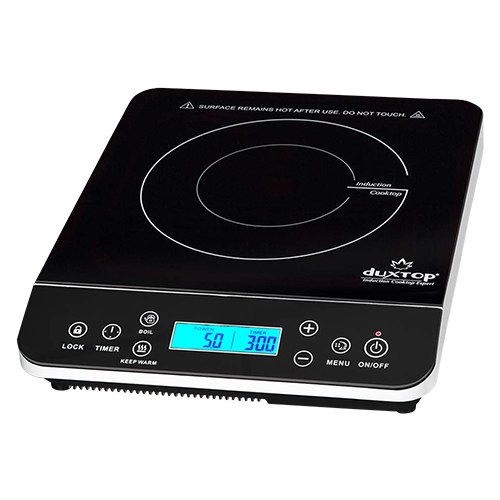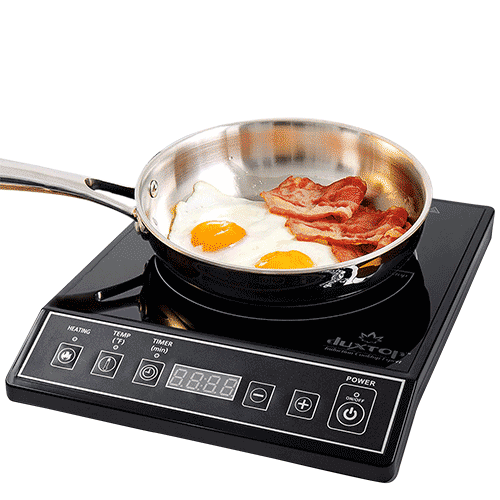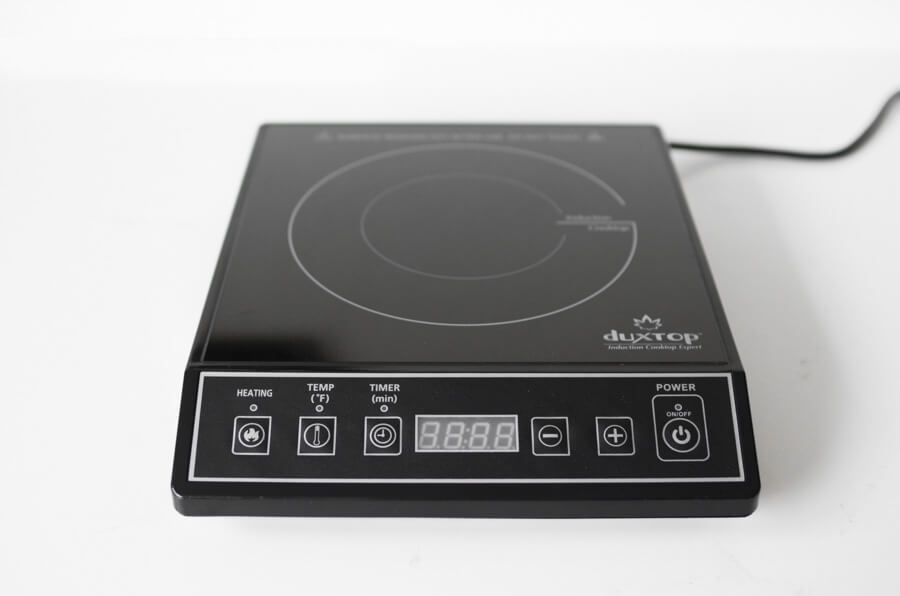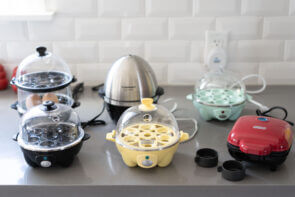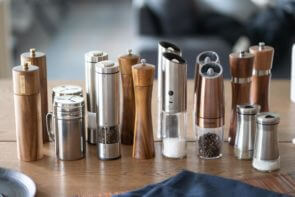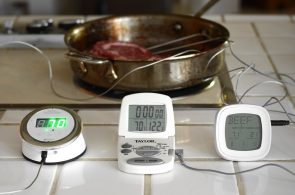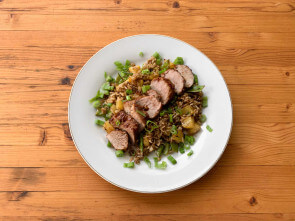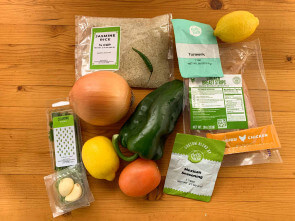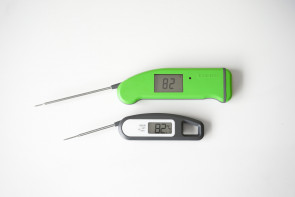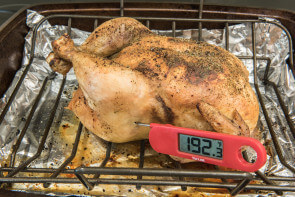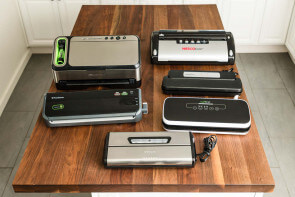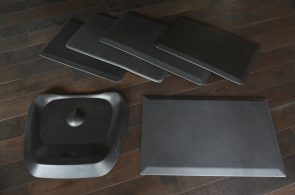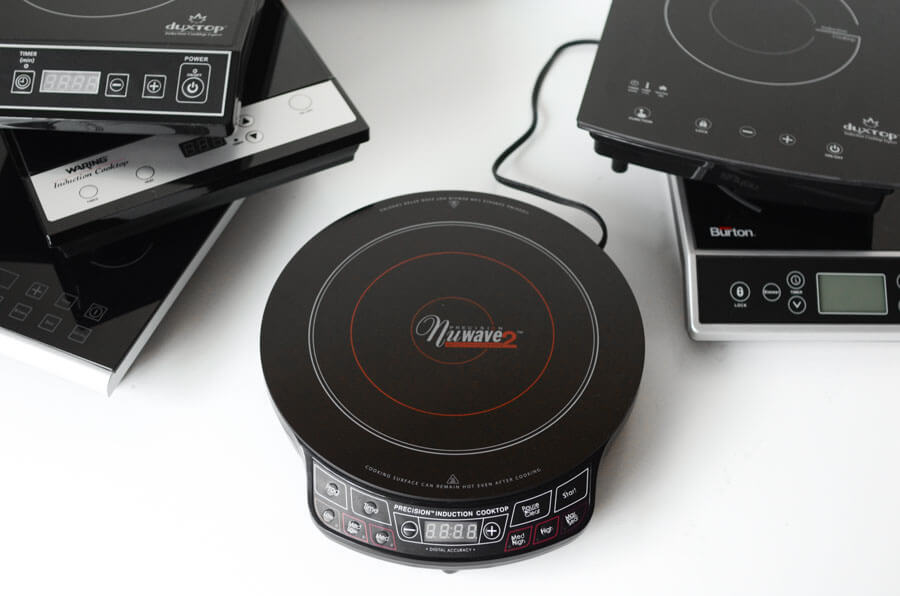
The Best Portable Induction Cooktops
After over 40 hours of researching and testing, we found the Duxtop – 9600LS to be the best portable induction cooktop. The sleek Duxtop has an intuitive and user-friendly design and precise temperature and power controls for increased accuracy in cooking. Our runner-up, the Secura – 9100MC, has a straightforward display panel and 10 power modes with a wide temperature range.
After over 40 hours of researching and testing, we found the Duxtop – 9600LS to be the best portable induction cooktop. The sleek Duxtop has an intuitive and user-friendly design and precise temperature and power controls for increased accuracy in cooking. Our runner-up, the Secura – 9100MC, has a straightforward display panel and 10 power modes with a wide temperature range.
Table of contents
- The 9 portable induction cooktops we tested
- Best overall: Duxtop – 9600LS
- Also great: Secura – 9100MC
- Other products we tested
- How we selected
- How we tested
- Induction cooktops vs. electric vs. gas
- What is induction-compatible cookware?
- Important features to consider
- The bottom line
(Editor’s note: In 2019 we learned that our top pick, the NuWave – PIC2, had been discontinued. In fact, NuWave has discontinued all induction cooktops, except for one model, which is only available on NuWave’s website. Also, Fagor America was shut down by its parent company in Spain, and so all Fagor products, including the induction cooktop we reviewed, have been discontinued. In October 2019, we tested three new induction cooktops to see how they compared with those we previously reviewed.)
The 9 portable induction cooktops we tested
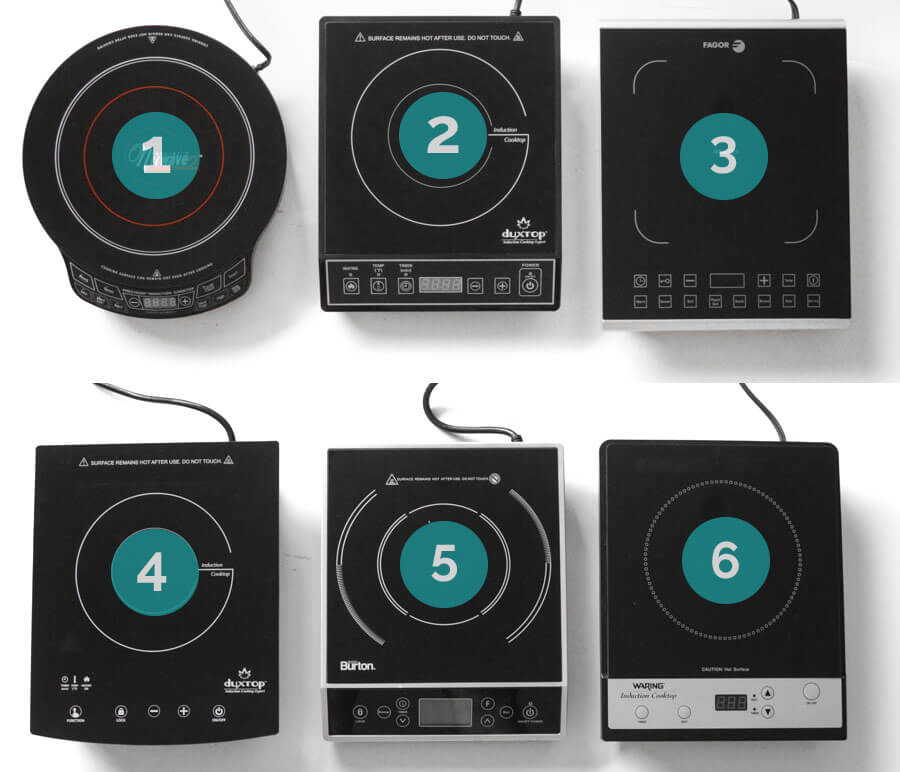
| Product | Price | Temp. Range (°F) | Temp. Increments | # of Temp. Settings |
|---|---|---|---|---|
| Duxtop - 9600LS | $$$ | 100-465 | 20° | 20 |
| Secura - 9100MC | $$$ | 140-460 | 20° or 30° | 10 |
| IsiLER | $$ | 140-460 | 40° | 9 |
| Rosewill - RHAI-15001 | $ | 150-450 | 40° | 8 |
| Duxtop - 8300ST | $$ | 140-460 | 30° or 40° | 10 |
| Max Burton - 6400 | $$$ | 100-450 | 10° | 2 |
| Waring Pro - ICT200 | $ | n/a | n/a | 8 |
| NuWave - PIC2 - Discontinued | $$$ | 100-575 | 10° | 6 |
| Fagor - 670041900 - Discontinued | $$$ | 140-465 | 10° | 8 |
Best overall: Duxtop – 9600LS
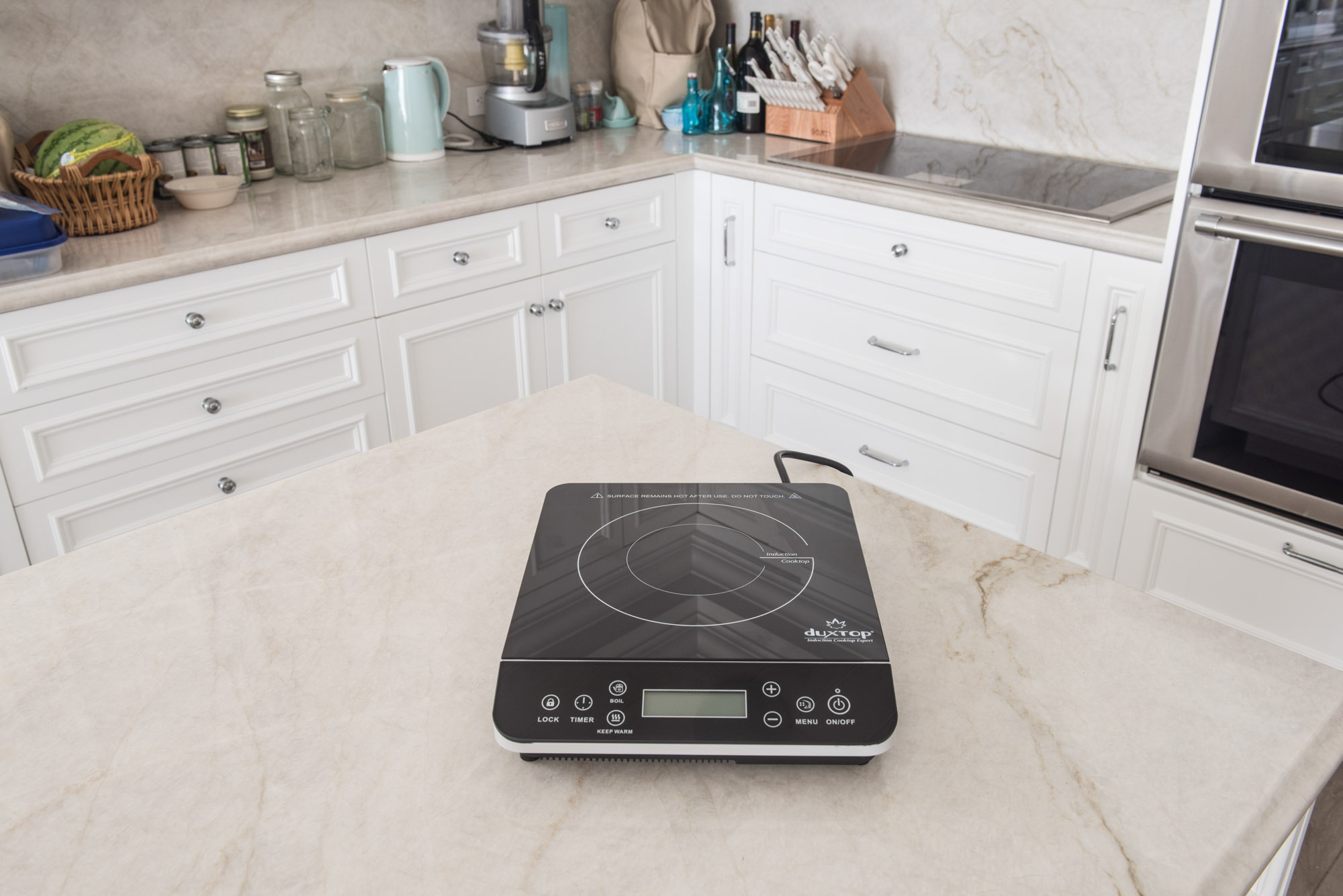
The Duxtop – 9600LS is the company’s most recently released induction cooktop. Duxtop was bought by Secura, and consequently, some Duxtop products are also branded as Secura. Adding to the confusion, Secura has its own separate line of induction cooktops, which are almost identical to Duxtop cooktops.
The 9600LS is a powerful 1800-watt cooktop that can be programmed for 100 ℉ – 460 ℉. Like other induction cooktops we tested, wattage can also be programmed, but during our testing, we found it easier to just use temperature.
The 9600LS’s menu gives you options to increase or decrease power and temperature in small increments, which gave us control when melting butter. The other induction cooktops that we tested for this 2019 update were too hot, even at their lowest setting, which caused the butter to burn. But since the 9600LS’s lowest temperature is set at 100 ℉, the butter slowly melted, and when we increased the temperature by 20 degrees, the butter kept warm without burning.
The ability to precisely control temperature was a big bonus in our pancake test. When the pan got too hot, we could immediately decrease the temperature incrementally so the pancakes wouldn’t burn. Temperature could not be as easily adjusted with the other two new cooktops we tested, and it seemed impossible to not cook pancakes that weren’t burned.
As with all induction cooktops, you’ll need the right cookware, and if you’re not using an induction-friendly pot or pan, the 9600LS will flash a warning on its bright LED panel and lock the programming menu. One of the 9600LS’s programs is for boiling water, and it brought a pot of water to a roiling boil in 3.5 minutes, which was 30 seconds faster than all of the other cooktops we previously tested.
Another improvement in the newer models that was particularly striking is that whereas all of the older models took 31 to 60 minutes to be cool enough to touch when they were turned off, all of the newer models we tested cooled down in under 10 minutes. The 9600LS was cool (and safe) to touch after only 8 minutes.
The Duxtop 9600LS is substantially more expensive, but it did outperform the other cooktops, simply by giving us more control in temperature and power. For now — until Secura upgrades Duxtop again — the Duxtop 9600LS is one of the best top-of-the-line cooktops.
Key takeaways:
- The Duxtop 9600LS is a powerful 1800-watt induction cooktop with precise temperature and wattage controls.
- The 9600LS heats up faster and cools down faster than older models.
- The Duxtop’s default temperature is a low 100 ℉, adjusted in 20-degree increments, which helps prevent burning of food.
Also great: Secura – 9100MC
We were impressed with the Secura – 9100MC’s functionality and power modes. It has a good temperature range (140-460°F), boiling water faster any of the cooktops and cooling down in 39 minutes. The display-panel design is simple and straightforward with 10 power levels and a 120-minute maximum cooking timer.
The Secura – 9100MC melted butter with ease, made perfectly golden pancakes and had a straightforward and intuitive control panel. While this cooktop doesn’t have the extensive programming capabilities or 10-degree temperature increments that the NuWave has, we can’t help but feel that many cooks might not need those extra bells and whistles to have a great cooking experience.
Key takeaways:
- The Secura – 9100MC has a wide temperature range for greater versatility in cooking.
- It’s very user-friendly with a straightforward display panel and 10 power modes for accurate temperature control.
Other products we tested
NuWave – PIC2 (discontinued)
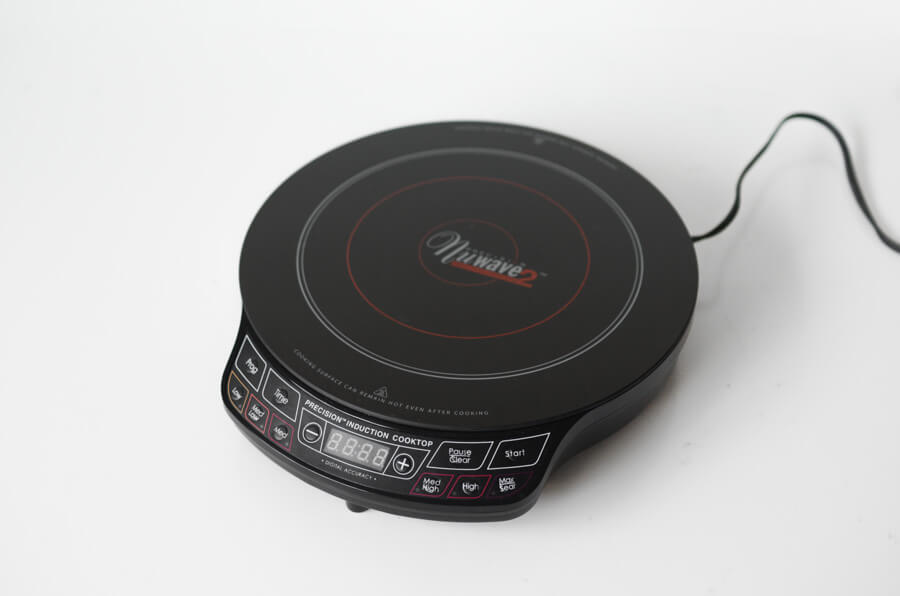
(Editor’s note: The Nuwave – PIC2 had been our top pick, but we learned in 2019 that it was discontinued and is no longer available.)
Of the six induction cooktops we originally tested, the NuWave – PIC2 cooked away the competition by its sheer capabilities. Even though the dimensions are similar to the other cooktops we tested, it felt more compact and less intrusive on our kitchen counter. With such robust capabilities, we were pleasantly surprised with how intuitive the display was. It didn’t take us more than a minute to figure out what buttons did what and how to get cooking.
With the broadest temperature range of all, 100-575 °F, a maximum programmable cooking timer of 99 hours and sixty minutes, (the next closest was the Fagor and Waring Pro at 180 minutes), a programmable memory, the least amount of watts (the most energy savings), the lightest weight, 10 °F temperature increment controls, six power modes, a sleek design, and a reasonable price.
We also appreciated The NuWave’s safety features. The extra-large vents in the back allow heat to escape more rapidly, keeping the cooktop cooler. Another plus is that the cooktop will automatically shut off if its internal temperature hits 230 °F. The NuWave also gives you the ability to program different heat levels at different times; for example, searing a steak and then simmering a pan sauce.
IsiLER
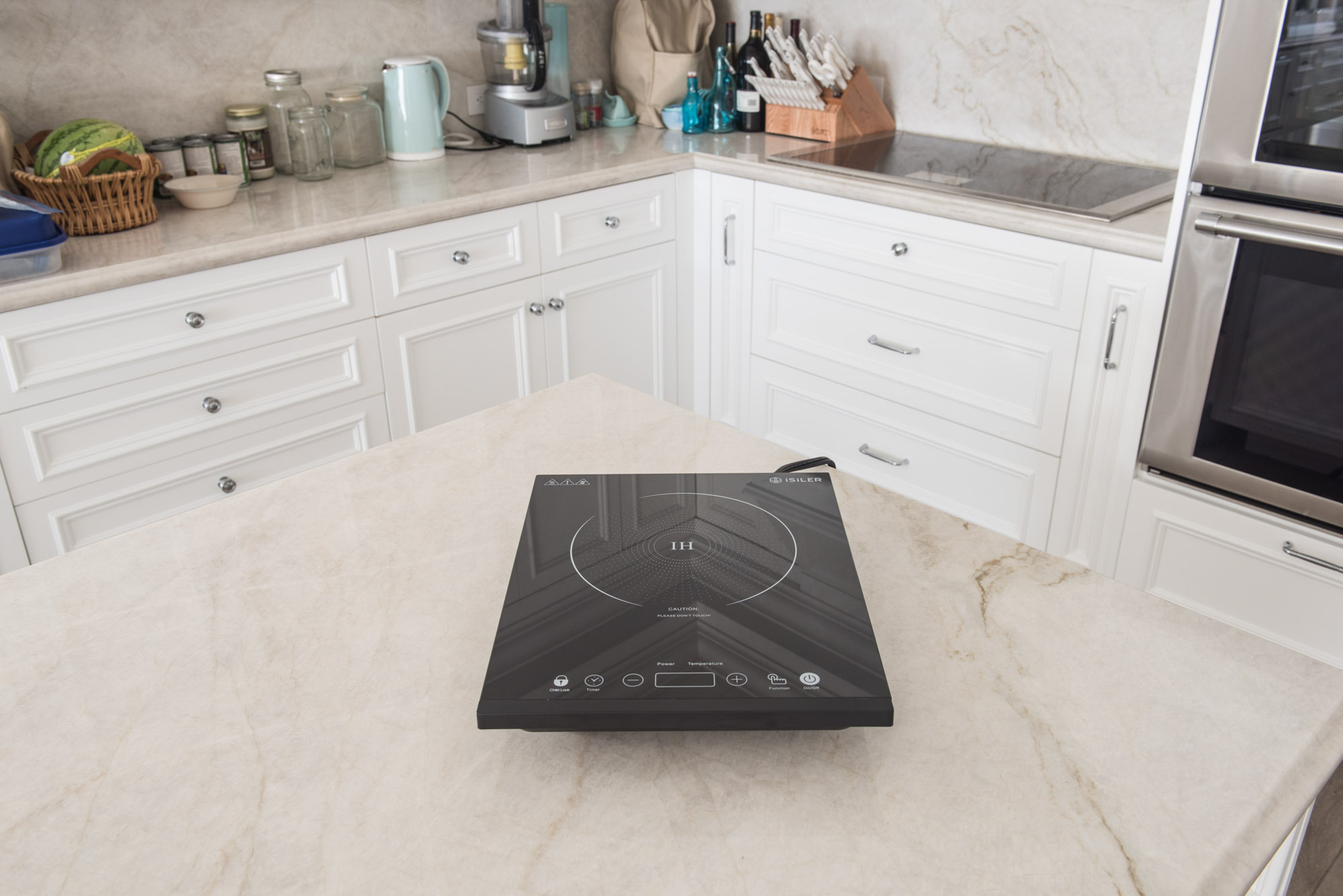
The IsiLER 1800-watt induction cooktop doesn’t have the Duxtop’s sleek curves, but it resembles most other new models and has the same functions. It has eight power levels, ranging from 100 watts to 1800 watts that can be selected in 200-watt increments. If you’re new to using an induction cooktop, then you’ll want to know what wattage level should be used for searing or slow cooking, but IsiLER provides no instructions other than the bare minimum. (There’s nothing on their website either.)
As with the Duxtop, we found it much easier to use the temperature function instead. The IsiLER doesn’t have as precise controls, however, only allowing you to increase or decrease temperature in 40-degree increments. Its lowest temperature setting is 140 ℉, but it was on the hotter side since butter melted and began to burn in seconds. The IsiLER was also too hot — again, even at its lowest setting — for pancakes, which burned around the edges before they were ready to be flipped.
IsiLER is new to the induction-cooktop business, and they’re aggressively marketing their product with deep discounts. It’s certainly tempting to pick up an induction cooktop at half the price of the Duxtop, but the IsiLER just isn’t on the same level.
Rosewill – RHAI-15001

The Rosewill – RHAI-15001 appears on a lot of “best of” lists and is highly rated by consumers on Amazon. It has a few features other induction cooktops don’t have. First, you don’t need to toggle back and forth between temperature and wattage when programming. A panel above the LED-display menu indicates temperature per wattage at the same time; for example, 300 ℉ equals 1000 watts.
The Rosewill also has helpful pictograms for its five programs: warm milk, soup, stir fry, fry and hot-pot. Soup and stir fry are both set at 400 ℉, while the other three settings have variable temperatures. The warm milk (represented by a baby-bottle pictogram) function is set at the Rosewill’s lowest temperature, 150 ℉. This default setting, which cannot be adjusted, burned butter in seconds and would likely scald milk. Overall, like the IsiLER, the Rosewill is calibrated too hot.
A stainless-steel pot with a tempered glass lid is included. The pot was designed specifically for the dimensions of the Rosewill. However, not only did it heat unevenly — pancakes either burned or were raw in the middle — but the bottom of the pot burned in spots, indicating a low-grade stainless steel.
Fagor – 670041900 (discontinued)
The Fagor – 670041900 is a sleek black cooktop with a smooth touchpad that feels luxurious. In addition to a fairly wide temperature range of 140-465 °F, the cooktop also has eight quick-launch buttons: warm, simmer, boil, rapid boil, saute, brown, sear and stir-fry.
When we put the Fagor to the boil test, we used the “Rapid Boil” quick-launch button, and the results were less than rapid compared to the other cooktops we tested. It took the Fagor 7 minutes, 2 seconds to boil, but the Fagor was the clear winner of the cool-down test, cooling in 31 minutes.
Duxtop – 8300ST
The Duxtop – 8300ST, recently updated to the Duxtop – 8310ST, also has a sleek design and is simple to use, with ten temperature settings ranging from 140-460 °F and 10 power modes. Its temperature increments are between 30 and 40 degrees, so if you’re looking for accuracy this isn’t the cooktop for you.
Max Burton – 6400
The Max Burton – 6400 was updated to the 6450, and although its physical appearance has changed, its controls are the same. While we liked the bright blue backlighting on the display of the Max Burton – 6400, this was the only unit we tested that we needed to consult the instruction manual. It has a temperature range of 100-450 °F, with 10-degree increments, but it lacks power-mode buttons, having only “simmer” and “boil.”
Waring – ICT200
Although its display was clear and user-friendly, the Waring – ICT200‘s physical design feels a bit cheap compared to the sleek touchpads on the other cooktops we tested. The Waring doesn’t have a temperature mode, so it was trial and error during testing to make sure nothing would burn. It’s very affordable, but it really is just a basic cooktop with minimal controls.
How we selected
We began our research by reading Amazon-consumer and chef reviews to learn what both professionals and non-professionals are looking for in an induction cooktop. The most popular cooktops were under $200, and so we focused on those that were below this price point.
After narrowing our selection a bit, we dove into the science of induction heating to help us determine the best single-burner induction cooktop. Finally, we headed to the kitchen and put these cooktops to work.
We tested their speed, cool-down times, temperature precision, and, most importantly, how each one cooked.
How we tested
Power
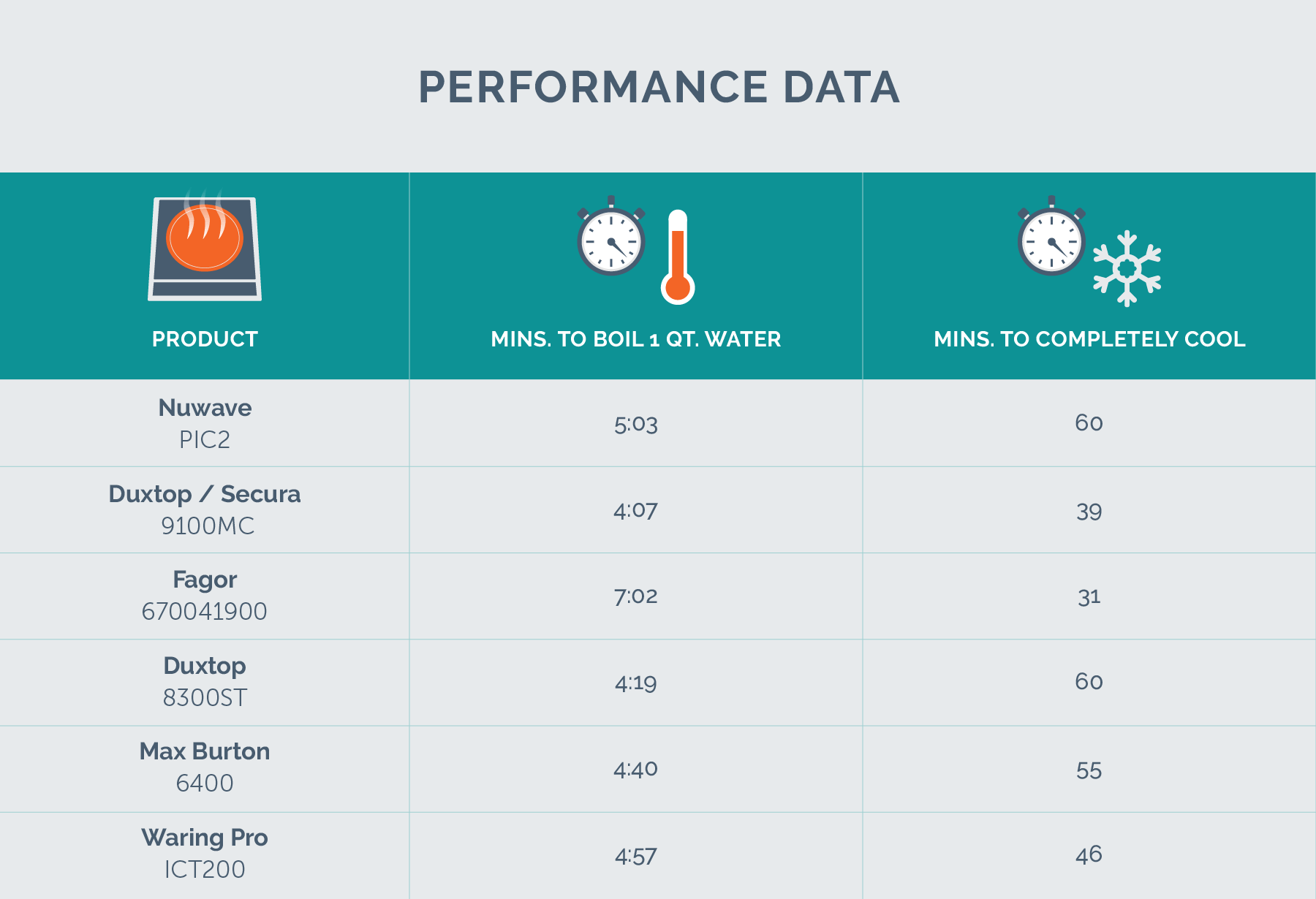
Our first test was a simple one: How long did it take for each cooktop to boil water?
The testing for this article was originally conducted in high altitude (7,000 feet), which affected the boiling point, decreasing it from 210 °F to 199 °F. For this 2019 update, we conducted the tests at sea level.
We used the same induction-friendly pot for all tests. We heated 1 quart of room-temperature water at the highest level and timed how long it took to come to boil. We started a second timer and kept the water boiling 5 minutes before turning the cooktop off. We then timed how long it took for the cooktop to cool completely.
When put to the test, the Secura – 9100MC came to a rapid boil the fastest at 4 minutes, 7 seconds. All of the cooktops were within a minute of each other except for the Fagor (now discontinued), which took 7 minutes, 2 seconds to come to boil. In our 2019 testing, the Duxtop – 9600LS beat all previous finalists by more than 30 seconds.
Temperature control
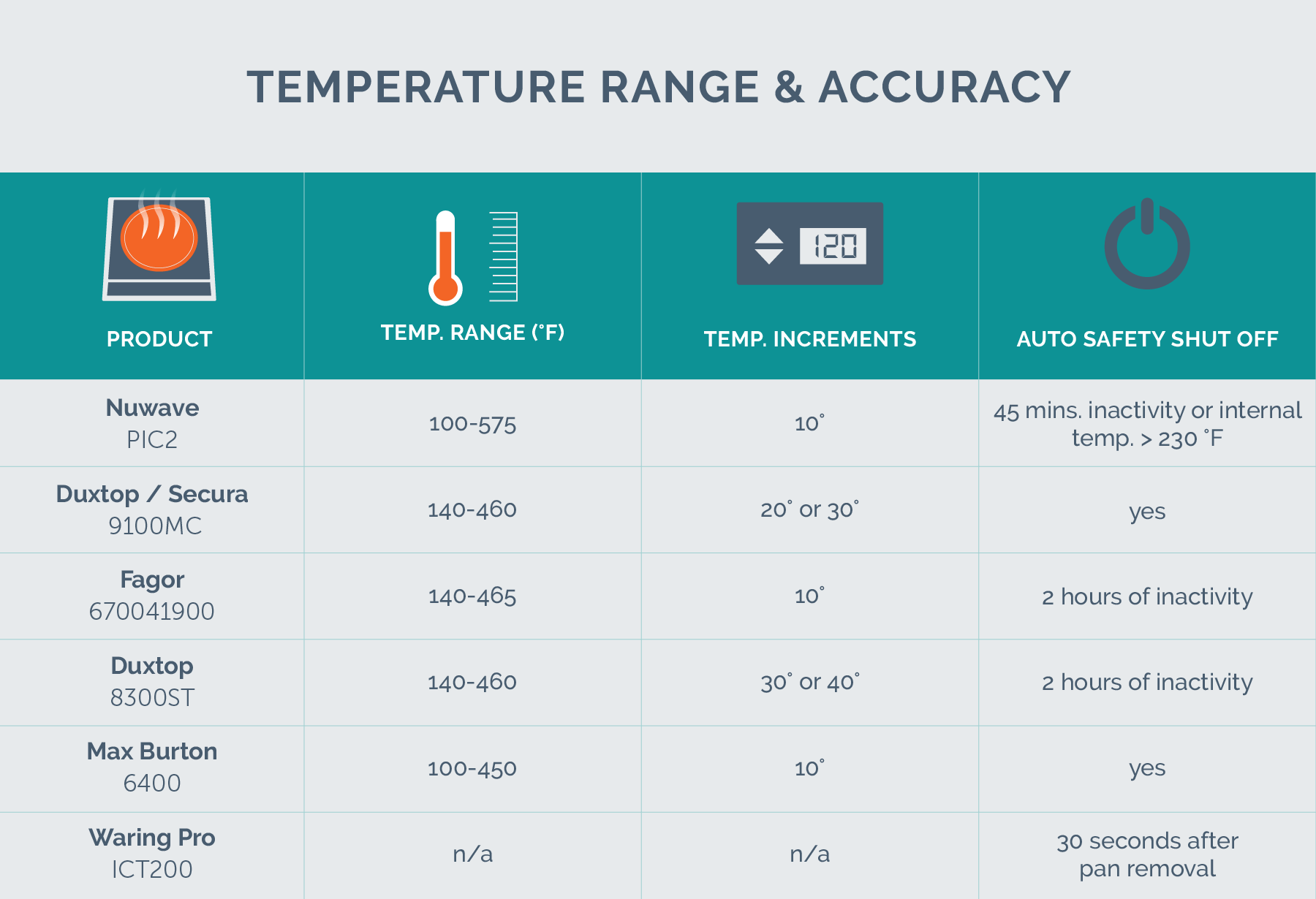
We tested how accurate each cooktop was by melting 2 tablespoons of butter at the lowest setting. The discontinued NuWave – PIC2 and the Max Burton performed the best because their lowest setting is at 100°F, which gently melted the butter and prevented it from browning too fast and burning. The NuWave, Max Burton, and Fagor could be adjusted in 10-degree increments, which gave us the most control.
In 2019 we had similar results. The Duxtop – 9600LS also has a low setting of 100 °F, and although it has 20-degree increments, we had sufficient control to keep the butter from burning. The IsiLER and Rosewill, however, had the same low settings (140°F) and increment control (40-degrees) as the previous models we tested, and the butter melted too quickly and burned.
Heating evenness
We tested how well heat was distributed by cooking pancakes in a cast-iron skillet. After the first batch, we adjusted temperature and power settings, and overall, each cooktop turned out golden-brown pancakes. The NuWave’s precise programming gave us more control, and its pancakes were the best. In our October 2019 testing, however, only the Duxtop cooked the pancakes evenly. Even at their lowest setting, the IsiLER and Rosewill burned the pancakes.
What is induction cooking technology?
In the 1860s, Scottish physicist James Maxwell articulated four mathematical formulas called Maxwell’s Equations, one of which applies to induction cooking: Where there is a changing flow of electricity, there is also a magnetic field.
Induction cooking uses this scientific formula to create a high-frequency magnetic field between the cooktop and the pot or pan placed upon the surface. The iron in the pan activates and completes the circulating electric current, which then generates heat.
It’s important to note that, although the induction cooktop will not heat until the proper pan is placed on top, the induction cooktop will then get searingly hot, and it should be handled with the same safety measures as you would with a gas or electric stovetop.
Induction cooktops vs. electric vs. gas
When comparing the various cooktops, gas is often preferred by professional cooks because it gives more control overheating. Electric coil is the slowest and takes time to increase or lower heat. Induction provides an instant reaction when the electromagnetic connection is made between the cooktop and pot, which can be adjusted in seconds.
Energy efficiency is dependent upon a number of factors. It is estimated by the Department of Energy that 60% of a gas flame’s energy is wasted unless the kitchen is well ventilated, as the heat will raise the temperature of the air in the kitchen. A newer study by the DOE also finds that an electric-coil cooktop could be more energy-efficient than induction if the pot that is used covers the entire diameter of the coil.
However, if you use the proper type of cookware, then induction is the most direct and thus efficient way to transfer heat from the cooktop to the pot.
What is induction-compatible cookware?
Induction-friendly cookware is cookware with iron or a high level of stainless steel. You can easily test this by seeing if a magnet will attach to the bottom of the pot or pan. Our top two picks on our review of nonstick cookware sets also happen to be induction-compatible.
Iron and stainless steel are ferromagnetic, which means they have an unbalanced set of electrons and can be influenced by magnetic fields (the induction cooktop).
The magnetic field of the cooktop penetrates the iron in the pan and a circulating electric current is established between the cooktop and pan, which activates the pan to heat. Cast iron is perhaps the easiest to identify as a sure winner when it comes to compatibility.
Stainless steel on its own has iron present, but it is manufactured with a wide range of other ingredients in varying amounts, including nickel, aluminum, chromium, and carbon, which are not conducive to induction cooktops. You need to confirm with the manufacturer as to whether the stainless steel cookware (like All Clad, for example) is, in fact, induction-friendly.
Important features to consider
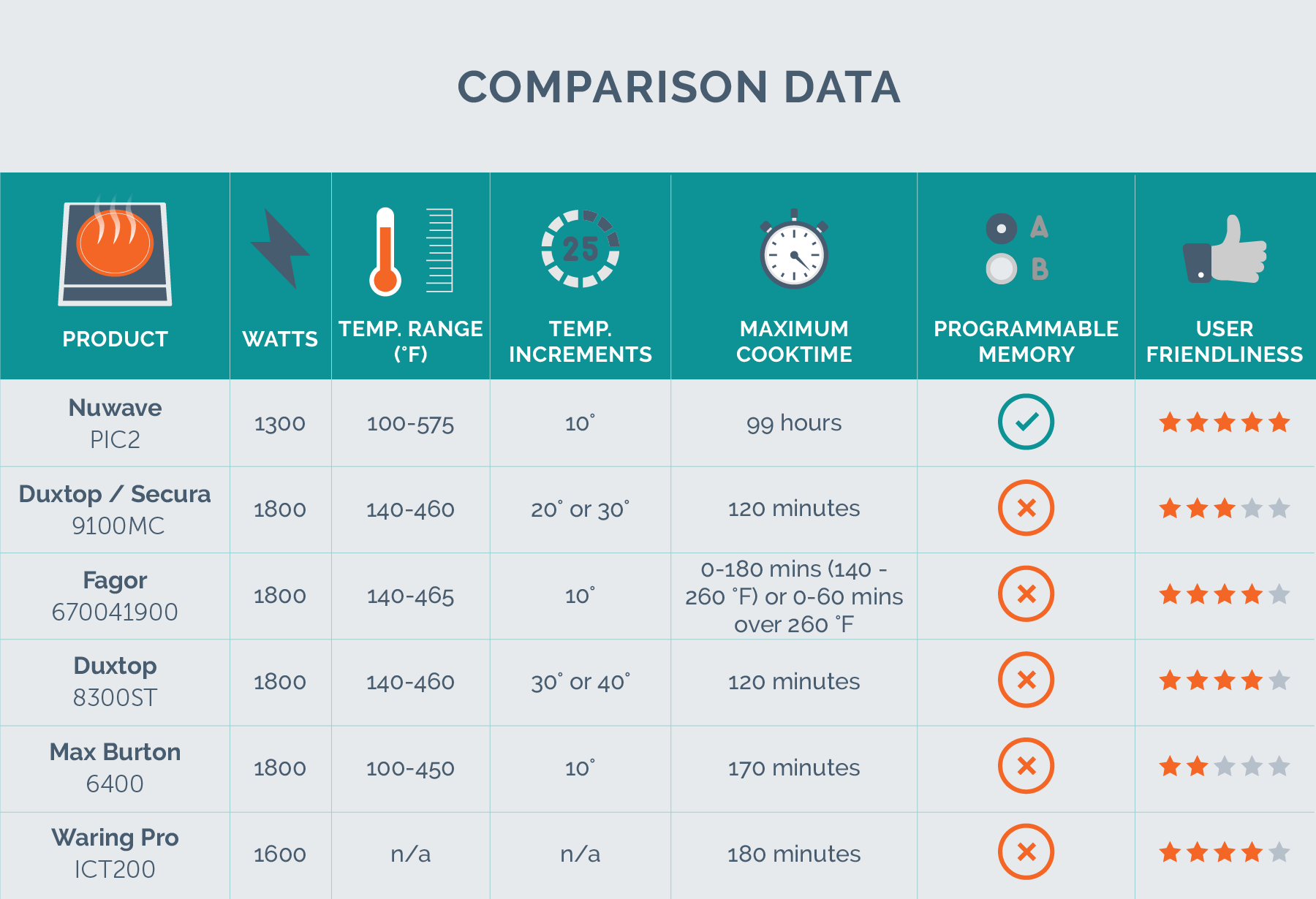
Volts/Watts: The most common analogy that describes the functional difference between volts and watts in electricity is to think of water flowing through a pipe. In this scenario, the water pressure is the voltage and the watts are the power the water could provide. The voltage for some induction cooktops is more than a typical household socket can handle, but all of the ones we tested are 120 volts.
Temperature mode (range and increments): The broader the temperature range, the more capacity for keeping food warm on the low end and achieving a restaurant-quality sear on the high end. During our testing, we learned that options for temperature increments were the most important for cooking accuracy.
Power mode: The power mode often includes choices for “simmer,” “boil” or heat levels.
Safety features: Look for options for pause/cancel and child lock. Many induction cooktops also have auto shut-off if the internal temperature of the cooktop itself overheats. In our previous testing, the induction cooktops took 31 to 60 minutes to cool down. However, for this 2019 update, the three new cooktops we tested all cooled down in under 10 minutes.
The bottom line
In October 2019, we tested the Duxtop – 9600LS, and it proved to be superior to our previous top pick. Secura — the company that manufactures Duxtop products — has given this new model more precise temperature and power controls that give you superb accuracy in cooking.
The Secura – 9100MC still remains our runner-up with its low-wattage energy savings, robust temperature range, and programming ability. Compared with the new induction cooktops we tested for this update, it still remains one of the best.
More Reviews
The 8 Best Electric Egg Cookers
Elite Gourmet - EGC-007B
The 8 Best Salt and Pepper Grinders
Merazi Living
Blue Apron
Martha & Marley Spoon
HelloFresh Meal Delivery Kit Review
HelloFresh
Windex
Mueller - MFFVS-01


